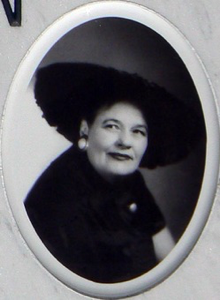Josephine Mahaffey
American, (1903–1982)
Words alone do not adequately describe Josephine Mahaffey's burning need to paint. In 1957 she was nicknamed Mama Mahaffey, the Texas Dynamo by Coronet Magazine in recognition of the thousands of artworks she had produced up to that time. Her career, as it turned out, still had twenty-five years to go. Working in the moment, she combined rapid brushstrokes with earthiness and high energy to produce an astonishingly large and complex legacy of art.
Josephine Mahaffey was born into a rural farming family in Hopkins County, Texas in 1903. She moved to Fort Worth as a newlywed in 1922 and began receiving art instruction from Sallie Blyth Mummert. Mahaffey's gift for rapid composition soon emerged. She called it direct painting. "You've got to get it down fast," Mahaffey once said, "or else you lose it."
Mahaffey's rapid-fire brushwork and bold color selections resulted in dizzying but unfailingly coherent translations of the world around her. For inspiration she typically looked to the faces of family and friends, the barnyard and gardens of her Jacksboro Highway farm, the shores of Lake Worth, and the urban landscapes of Fort Worth itself. In later years, and despite her gregarious nature, she eschewed the familiar and turned inward.
Mahaffey worked primarily in water-based paints but was proficient in the use of oil paints and encaustics when economics allowed. In a pinch she was known to execute paintings on newsprint, brown paper bags, small bits of cardstock, roadmaps, and in one case a Styrofoam egg carton. The choice of media and type of surface on which to work was always secondary to the act of painting.
Over time, Josephine Mahaffey's career branched out into teaching and advocacy. For many years she taught at the Woman's Club of Fort Worth, the Fort Worth Art Center, the northside Boy's Club, and the Arlington YWCA. Mahaffey's policy was to offer art lessons whether or not a student could pay.
Josephine Mahaffey, a mother of eight, never stopped growing as an artist and observer of life. Though she died in 1982, her influence lives on in scores of north Texas collections. Now as then, her art remains an enduring testament to the wonder of human creativity and the infinite beauty of the human mind. -- Scott Grant Barker
American, (1903–1982)
Words alone do not adequately describe Josephine Mahaffey's burning need to paint. In 1957 she was nicknamed Mama Mahaffey, the Texas Dynamo by Coronet Magazine in recognition of the thousands of artworks she had produced up to that time. Her career, as it turned out, still had twenty-five years to go. Working in the moment, she combined rapid brushstrokes with earthiness and high energy to produce an astonishingly large and complex legacy of art.
Josephine Mahaffey was born into a rural farming family in Hopkins County, Texas in 1903. She moved to Fort Worth as a newlywed in 1922 and began receiving art instruction from Sallie Blyth Mummert. Mahaffey's gift for rapid composition soon emerged. She called it direct painting. "You've got to get it down fast," Mahaffey once said, "or else you lose it."
Mahaffey's rapid-fire brushwork and bold color selections resulted in dizzying but unfailingly coherent translations of the world around her. For inspiration she typically looked to the faces of family and friends, the barnyard and gardens of her Jacksboro Highway farm, the shores of Lake Worth, and the urban landscapes of Fort Worth itself. In later years, and despite her gregarious nature, she eschewed the familiar and turned inward.
Mahaffey worked primarily in water-based paints but was proficient in the use of oil paints and encaustics when economics allowed. In a pinch she was known to execute paintings on newsprint, brown paper bags, small bits of cardstock, roadmaps, and in one case a Styrofoam egg carton. The choice of media and type of surface on which to work was always secondary to the act of painting.
Over time, Josephine Mahaffey's career branched out into teaching and advocacy. For many years she taught at the Woman's Club of Fort Worth, the Fort Worth Art Center, the northside Boy's Club, and the Arlington YWCA. Mahaffey's policy was to offer art lessons whether or not a student could pay.
Josephine Mahaffey, a mother of eight, never stopped growing as an artist and observer of life. Though she died in 1982, her influence lives on in scores of north Texas collections. Now as then, her art remains an enduring testament to the wonder of human creativity and the infinite beauty of the human mind. -- Scott Grant Barker
Artist Objects


